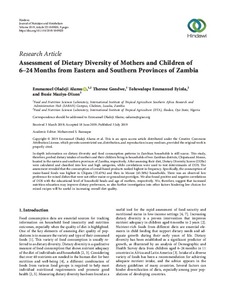| dc.contributor.author | Alamu, E.O. |
| dc.contributor.author | Gondwe, T. |
| dc.contributor.author | Eyinla, T.E. |
| dc.contributor.author | Maziya-Dixon, B. |
| dc.date.accessioned | 2019-12-04T11:36:07Z |
| dc.date.available | 2019-12-04T11:36:07Z |
| dc.date.issued | 2019-07-03 |
| dc.identifier.citation | Alamu, E.O., Gondwe, T., Eyinla, T.E. & Maziya-Dixon, B. (2019). Assessment of dietary diversity of mothers and children of 6-24 months from eastern and southern provinces of Zambia. Journal of Nutrition and Metabolism, 1-9. |
| dc.identifier.issn | 2090-0724 |
| dc.identifier.uri | https://hdl.handle.net/20.500.12478/6110 |
| dc.description | Open Access Journal |
| dc.description.abstract | In-depth information on dietary diversity and food consumption patterns in Zambian households is still scarce. This study, therefore, probed dietary intakes of mothers and their children living in households of two Zambian districts, Chipata and Monze, located in the eastern and southern provinces of Zambia, respectively. After assessing their diet, Dietary Diversity Scores (DDSs) were calculated and classified into low and high categories, while correlations were used to test determinants of DDS. The assessment revealed that the consumption of cereal-based products ranked highest in frequency. Specifically, the consumption of maize-based foods was highest in Chipata (55.43%) and then in Monze (43.56%) households. There was an observed low preference for mixed dishes that were not either maize or groundnut porridges. We also found positive and negative correlations of DDS with the educational level of household heads and age of mothers, respectively. We, therefore, suggest that increased nutrition education may improve dietary preferences, so also further investigation into other factors hindering low choices for mixed recipes will be useful in increasing overall diet quality. |
| dc.format.extent | 1-9 |
| dc.language.iso | en |
| dc.rights | CC-BY-4.0 |
| dc.subject | Information |
| dc.subject | Households |
| dc.subject | Food Consumption |
| dc.subject | Data Collection |
| dc.title | Assessment of dietary diversity of mothers and children of 6-24 months from eastern and southern provinces of Zambia |
| dc.type | Journal Article |
| dc.description.version | Peer Review |
| cg.contributor.crp | Agriculture for Nutrition and Health |
| cg.contributor.crp | Maize |
| cg.contributor.crp | Roots, Tubers and Bananas |
| cg.contributor.crp | Grain Legumes |
| cg.contributor.affiliation | International Institute of Tropical Agriculture |
| cg.coverage.region | Africa |
| cg.coverage.region | Southern Africa |
| cg.coverage.country | Zambia |
| cg.creator.identifier | Alamu Emmanuel Oladeji: 0000-0001-6263-1359 |
| cg.creator.identifier | Therese Gondwe: 0000-0002-4522-7060 |
| cg.researchtheme | NUTRITION & HUMAN HEALTH |
| cg.researchtheme | PLANT PRODUCTION & HEALTH |
| cg.isijournal | ISI Journal |
| cg.authorship.types | CGIAR single centre |
| cg.iitasubject | Food Science |
| cg.iitasubject | Food Security |
| cg.iitasubject | Livelihoods |
| cg.iitasubject | Nutrition |
| cg.iitasubject | Plant Health |
| cg.iitasubject | Plant Production |
| cg.journal | Journal of Nutrition and Metabolism |
| cg.howpublished | Formally Published |
| cg.accessibilitystatus | Open Access |
| local.dspaceid | 106319 |
| cg.targetaudience | Scientists |
| cg.identifier.doi | https://dx.doi.org/10.1155/2019/1049820 |

